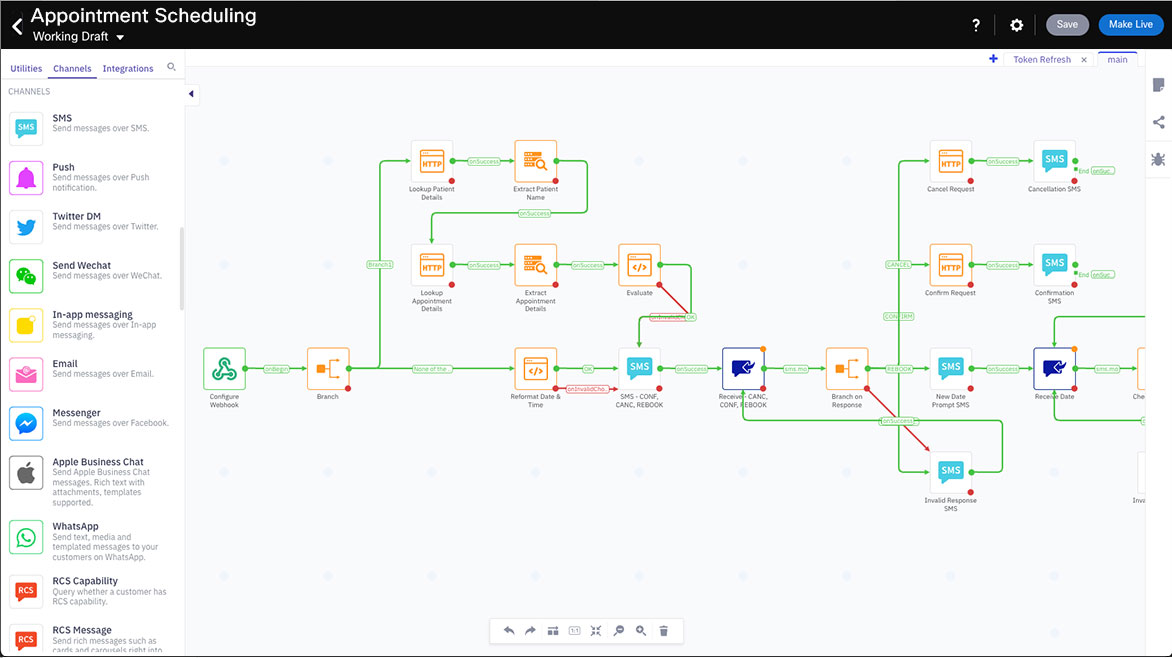Five IT challenges that an Enterprise CPaaS platform can resolve
Exploring the challenges that enterprise IT teams face and how an Enterprise CPaaS platform can be the potential solution.

Contents
The lines between business and IT teams have become increasingly blurred. With interactions from customers skyrocketing due to their increased dependency on businesses’ online products and services, delivering exceptional customer experiences has become a common goal for all departments with IT driving the digital transformation. Research predicts that the future of digital applications and CX transformation depends on the collaborative efforts between IT and the business units.
To be successful, businesses need to evaluate how their IT teams are equipped to perform and execute at scale and how business goals can be aligned to deliver exceptional customer experiences, while achieving efficiency in resources, time, and costs.
In this blog, we explore five IT challenges that can potentially slow down CX transformation for businesses and their solutions:
1. Evaluating the availability of resources
Successful CX for businesses has evolved into anticipating customers’ needs and innovating to serve customers where they are, quickly, and at scale whilst also reducing costs. This has put immense pressure on IT teams to accelerate their development projects. Businesses are stretched for IT resources who can develop applications for end-to-end customer journeys across multiple communication channels, integrate communications with existing applications and processes, and maintain existing systems simultaneously. Additionally, developers must also manage these increasingly complex environments, and keep up with new channels, policy changes or system upgrades that will need reprogramming.
The increasingly popular low code tools that are built into a cloud-based communications platform as a service (CPaaS) can empower IT by speeding up the development process with pre-built components that users can drag and drop within a visual interface to create and deploy customer journey applications or communications at scale. These low code platforms further help IT to analyze and evaluate customer journey performance with in-built advanced reporting capabilities like flow analytics and custom reports.
One of our clients was able to scale their customer communications to deliver 20 projects in 5 months that would have typically taken over a year to deliver using our low-code Enterprise CPaaS platform.
Explore the power of an enterprise-grade platform.
2. Optimizing time and costs to enhance customer journeys
Customers today expect businesses to be always available on the channels they prefer. Relying solely on in-house development may take months or years to bring these customer journeys to life, leaving businesses at the risk of losing their competitive edge to newer players posing a threat to businesses’ revenue.

Businesses need a wide range of resources like developers having the relevant skills, to the right backend infrastructure, business system knowledge and understanding of communication channels. This often means having to hire external resources or use vendors who can manage these services, which can be costly. Alternatively, businesses will need to invest in training existing IT staff to add new channels or build applications based on changing customer needs. Both approaches result in businesses having to invest time and money, at a time when businesses are looking to optimize their operational efficiency.
From our experience, businesses can rapidly innovate by reducing the time taken to build and maintain journeys using a low code platform. A CPaaS platform hosted in the cloud also eliminates the need for businesses to host these journeys on their servers further reducing costs.
A leading telecom operator in the UK adopted a low-code platform to deliver and manage targeted campaigns to their customer base. The telco now sends over 750 million customer interactions a year across multiple communication channels leveraging the low-code components of the platform to bring operational efficiency and reduce IT development effort.
3. Working with legacy systems and data silos
Most businesses have an existing technology infrastructure to support their customer facing channels and journeys. These legacy systems were built to do a specific function, extending the capability can require significant reprogramming for each modification. The systems now lack the flexibility and agility to accommodate newer digital channels based on evolving customer needs slowing down businesses’ digital transformation.
“If you can have as much (journeys) as you can in one platform then the training and upskill required is significantly shorter. When you think of adding multiple channels, really think about what technology you are going to use to achieve all of that, because the more tech you are going to introduce, if it doesn’t all fit together nicely like a jigsaw, you are going to find some challenges when you’re shifting your agents from one channel to the next.”Gemma Crask, Product Owner, British Gas.
These legacy systems greatly restrict IT teams’ ability to rapidly build and enhance customer journeys at scale. Adding new capability such as messaging channels requires developers to spend a significant amount of time ‘hard-coding’ each of the features. Customer data stored in siloed systems further adds to the complexity for IT teams who must write code for data to flow from each of these systems to gather customer insights.
With customer interactions rarely interacting with just one system but needing to integrate and pull data from multiple systems, today’s businesses need a flexible, central communications platform that can reduce the time, effort and technical complexity for IT teams, and connect into disparate systems to deliver a connected experience for the customer.
4. Achieving speed-to-market
Delivering great customer experiences is one of the key competitive advantages for businesses. CX has only recently pivoted to being a customer-centric strategy which means that most IT teams are still focused on one-way communications that are not personalized to suit customer preferences.
A financial services firm in the US was able to reduce several hours’ worth of manual work across multiple departments by integrating its databases with our Enterprise CPaaS platform. The integration allowed its agents to update client location data in real-time. Implementing this solution using an Enterprise CPaaS platform enabled the business to go live within weeks compared to the several months of programming and development.
What great CX means for each department within a business has also been siloed with each department having its own KPIs that do not converge, leading to a disjointed experience for the customer. IT teams and other lines of business (LOBs) will need to come together to build end-to-end customer journeys that deliver consistent and connected customer experiences at scale.
A flexible approach to developing and managing customer journeys end-to-end will help businesses fast-track their go-to-market. Businesses today have a choice to either leverage APIs that allow them to quickly get on board with the channels their customers use, or alternately can opt for low-code pre-built capabilities and journeys that can automate and orchestrate customer journeys across multiple channels, resulting in greater efficiency while saving time and reducing costs.
5. Delivering CX projects at scale
Digital native businesses like Uber, Netflix, and Amazon have brought a new wave of customer experience and expectations. Time taken to develop, test, deploy, and manage customer journeys will be the differentiating factor for businesses in meeting customer expectations.
Deploying customer journeys at scale using code not only increases the dependency on IT teams but also slows down the rate of digital transformation which businesses cannot risk. It also affects IT teams’ ability to focus on other core aspects of their roles like infrastructure maintenance and cybersecurity that are crucial for the business’ well-being. IT teams need to build and configure customer journeys quickly at scale on a cloud-based platform that is secure with assured delivery of customer communications on a large scale.
Customers today want to take control of their experiences and fast-track their interaction with businesses, where a self-serve mode is becoming the default.
In addition, businesses have an opportunity to identify customer journeys that can be automated using pre-built technologies like NLP and AI which not only reduce programming effort for IT teams but can add efficiency to the business by providing self-serve avenues to resolve customer issues without the need for human agents. This reduces the business’ cost-to-serve while attending to customers around the clock.
Our low code enterprise CPaaS platform has enabled several high-street banks to identify and alert millions of customers of potentially fraudulent transactions. While the solution was instantly welcomed by customers and saw response rates of nearly 80%, the banks were able to expand their digitization efforts to offer a more interactive experience to their customers while reducing costs.
How does an Enterprise CPaaS platform help?
The CPaaS platform enables easy collaboration for all parts of the business allowing the management of customer journeys end-to-end while offering the flexibility to each department to customize the operations based on its KPIs. A low-code enterprise CPaaS platform provides the opportunity for business users and IT teams to collaborate seamlessly to build, test, and deploy customer journeys much faster and at scale with minimal coding effort.
For example:
Business analysts can configure customer survey journeys on the platform using the visual flow builder and monitor the responses.
IT teams can configure custom integrations that interact with multiple third-party applications and bring customer insights into the customer journey.

Its configuration-based approach enables IT teams to minimize the time spent on coding complex custom logic into customer journeys while enabling business users to build tailored customer journeys using pre-built drag-and-drop tools.
The visual way of building customer communication flows helps businesses remove dependency on IT teams and leverage their skills for more mission-critical projects. This strategy of collaboration helps businesses meet customer expectations rapidly without having to expand on existing staff or spending hours of development effort leading to a slower go-to-market.
Achieve your CX goals with an Enterprise CPaaS solution. Learn how to get started using our IT buyer’s guide for CPaaS, or get in touch with our experts to book a demo today.


